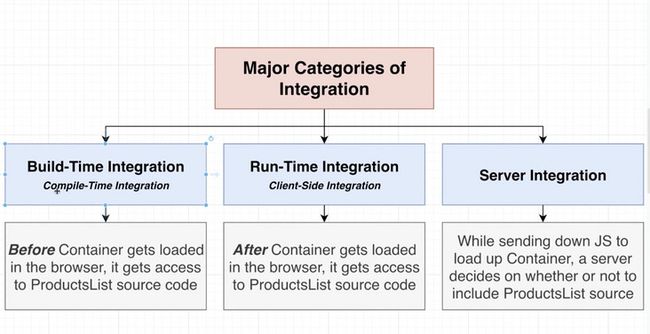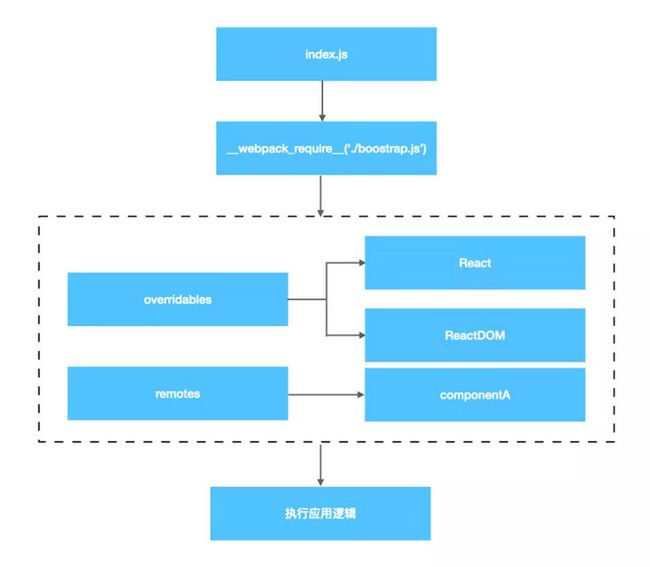webpack 5 模块联邦实现微前端
微前端:将巨大的单体前端系统拆分成多个独立的小型系统,最后集成为一个系统的架构思路,分而治之,让系统
更加容易维护、更易扩展,实施微前端是一个先拆分,后合并的过程。
这里的前端应用指的是前后端分离的单页应用,在这基础上谈论微前端才有意义。
微前端和微服务都是为了解决大项目和大团队的难题:大项目实现模块解耦,大团队实现人员解耦,这两大难题是《软件工程
》这门课程研究的主要问题。康威定律:软件结构体现人员结构,人员结构决定软件结结构。
为何需要微前端
巨石单体系统随着业务的增加,变得越来越臃肿,多个团队一起开发,沟通成功高,编译、部署、测试、维护困难,微前端可解决这些问题。
- 应用自治:各个应用相互独立,规模更小,更容易扩展、测试、构建、维护、排错、升级依赖等;
- 团队自治:应用独立后,团队也会独立,减少很多人在一个巨石应用中同时开发,相互影响,提高开发效率;
- 技术无关:各个应用可选择不同的框架开发,尽量保持统一,否则应用之间交互会可能遇到麻烦,也不利于组件复用,比如无法
共享组件级别的代码; - 尝试新技术:应用拆分后,很容易在系统里尝试新技术。
- 老系统增量重构。
缺点:
- 代码规范统一比较困难(人员多、项目多),容易克服
- 开发时可能需要同时运行多个项目,容易克服
- 集成测试比较困难
- UI、交互等容易不统一,容易克服
相比微前端的优点,缺点基本可忽略不计。
实施建议:
- 一致的工作方法:团队成员要达成一致的工作方法,尤其是宿主应用和远程应用之间的交互协议,需要提前约定好;
- 结合业务:在使用为微前端架构之前,思考业务划分和微前端给团队给来的价值;
- 遵从一致的代码风格,方便后期维护;
- 不要过度使用:希望能实现拆分人员或者技术的目标,或者有必要拆分人员或者技术时才使用。
如何集成 --- 聚合
主要三种集成方式:
| 集成方式 | 具体描述 | 优点 | 缺点 | 其他 |
|---|---|---|---|---|
| 构建时集成 | 把微应用打包进入主应用,微应用通常以 npm 包发布 | 实施容易且很好理解 | 有依赖关系的应用之间,其中一个更新,另一个也要更新,然后部署,实际上无法独立部署 | 实际上这种方式并没有实现微前端的目标 |
| 运行时构建 | 主应用在浏览器加载后,再去获取微应用代码 | 独立部署,主应用能决定使用哪个微应用的版本,灵活,性能好 | 设置复杂,不好理解 | 实现微前端的目标,目前比较通用的方式 |
| 服务端集成 | 主应用向服务器请求微应用,服务器决定是否给代码 | 严重依赖后台代码 | 实现复杂,一般不使用 | |
集成时需要考虑哪些问题?
- 避免样式冲突
- 应用之间通信简单
- 不同应用之间导航丝滑
- 能集成特定版本
- 版本控制不相互干扰
- 能方便实现依赖共享
常见的微前端实施方案
微前端的架构方式出现后,业界出现一些框架和解决方案,常见的:
框架:
无裤架的解决方案:
web components 不推荐,无法提供模块化功能,项目越大,越容易失控,web component 本质是封装自定义的 html,会很快会到 jQuery 时代。
iframe
webpack5 module federation 模块联邦,webpack5 的一个新特性,可实现跨应用共享代码。
如何拆分微应用?
在拆分时,希望不同应用之间的交互最小为原则,最大程度解耦,以方便不同应用之间的通信,否则导致应用难以测试、问题难以定
位。
按照业务划分,相同的业务拆分到同一个微应用中。
按照权限划分,根据用户的权限,不同用户使用使用的功能划分到一起。
按照后台微服务划分,有的团队,后台使用微服务架构,可考虑按照微服务划分。
模块联邦 -- Module Federation
模块联邦是 webpack5 引入的特性,能轻易实现在两个使用 webpack 构建的项目之间共享代码,甚至组合不同的应用为一个应用。
模块联邦的配置
模块联邦可实现跨应用共享代码,以两个应用为例子说明其配置。
一个dashboard vue3 应用,希望提供代码给其他应用:
// const ModuleFederationPlugin = require('webpack/lib/container/ModuleFederationPlugin') // 导出模块联邦
const { ModuleFederationPlugin } = require('webpack').container // 还可以这样
// webpack 插件配置
{
plugins: [
new ModuleFederationPlugin({
name: 'dashboard', // exposeRemoteName 共享的模块名字,在消费该模块的应用中会用到 不能使用 -
filename: 'remoteEntry.js', // 远程加载的文件名字,在浏览器请求面板可看到,默认名字就是 remoteEntry.js
exposes: {
'./DashboardApp': './src/bootstrap', // 从本应用暴露的共享模块,可共享多个模块 key 以 ./ 开头,value 指向本地的一个文件
},
shared: packageJson.dependencies, // 希望共享的依赖
}),
],
}关于名字的设置
name 的值会被导出成一个全局变量,不要使用-,不要和页面里的 id 相同,否则可能报错。
container react 应用消费 dashboard
const ModuleFederationPlugin = require('webpack/lib/container/ModuleFederationPlugin')
{
plugins: [
new ModuleFederationPlugin({
name: 'container',// 希望共享的模块,虽然 container 没有被其他应用消费,声明名字是一个好的做法
remotes: {
// marketing: 'marketing@http://localhost:8081/remoteEntry.js',
// auth: 'auth@http://localhost:8082/remoteEntry.js',
dashboard: 'dashboard@http://localhost:8083/remoteEntry.js',// 指定远程模块
//NOTE remoteName:exposeRemoteName@fileOnRemoteServer
},
shared: packageJson.dependencies,// 希望共享的模块
}),
],
}如何在 container 使用 dashboard 呢?
在 container 中新建一个 DashboardApp.jsx 组件来引入 dashboard:
dashboard 是 container 里 remotes 的字段 DashboardApp 是 dashboard 在 exposes 里暴露而 key 是 dashboard 里导出的一个挂
载函数,可在 container 将该应用挂载到任何地方
// exposeRemoteName/expose
import { mount } from 'dashboard/DashboardApp' // NOTE 注意这里的写法和配置的对应关系
import React, { useRef, useEffect } from 'react'
import { useHistory } from 'react-router-dom'
export default ({ isSignedIn, user }) => {
const ref = useRef(null)
const history = useHistory()
useEffect(() => {
// NOTE 通过 mount 把 dashboard 挂载到 div 上,这些参数和返回值是实现数据共享的方式,稍后细说
const { onParentNavigate } = mount(ref.current, {
isMemoryHistory: true,
basePath: '/dashboard',
currentPath: history.location.pathname,
onNavigate: nextPathname => {
const { pathname } = history.location
if (pathname !== nextPathname) {
console.log('vue 子应用跳转', nextPathname)
history.push(nextPathname)
}
},
sharedData: { isSignedIn, user },
})
console.log('container dashboard navigate')
history.listen(onParentNavigate)
}, [])
return
}然后将该组件导出,放在/dashboard路径下,就可导航到 dashboard 了:
import React, { lazy, Suspense, useState, useEffect } from 'react'
import { Router, Route, Switch, Redirect } from 'react-router-dom'
import { StylesProvider, createGenerateClassName } from '@material-ui/core/styles'
import { createBrowserHistory } from 'history'
import { Progress, Header } from './components'
const MarketingLazy = lazy(() => import('./components/MarketingApp'))
const AuthLazy = lazy(() => import('./components/AuthApp'))
const DashboardLazy = lazy(() => import('./components/DashboardApp'))
const generateClassName = createGenerateClassName({
productionPrefix: 'co',
})
const history = createBrowserHistory()
export default () => {
const [isSignedIn, setIsSignedIn] = useState(window.localStorage.getItem('isSignedIn') === 'true')
const [user, setUser] = useState(JSON.parse(window.localStorage.getItem('user')))
useEffect(() => {
if (isSignedIn) {
history.push('/dashboard')
}
}, [isSignedIn])
return (
{
window.localStorage.removeItem('isSignedIn')
window.localStorage.removeItem('user')
window.sessionStorage.removeItem('user')
setIsSignedIn(false)
}}
isSignedIn={isSignedIn}
/>
{
setUser(user)
// 使用本地存储
window.sessionStorage.setItem('user', JSON.stringify(user))
window.localStorage.setItem('user', JSON.stringify(user))
window.localStorage.setItem('isSignedIn', JSON.stringify(true))
setIsSignedIn(true)
}}
/>
{/* {!isSignedIn &&
)
}dashboard 暴露出来的模块是怎样的呢?
dashboard 里 bootstrap.js
import { createApp } from 'vue'
import App from './App.vue'
import { setupRouter } from './route'
import { createWebHistory, createMemoryHistory } from 'vue-router'
function mount(el, { isMemoryHistory, basePath, currentPath, onNavigate, sharedData = {} }) {
const app = createApp(App, { basePath, currentPath, isMemoryHistory, onNavigate, sharedData })
const history = isMemoryHistory ? createMemoryHistory(basePath) : createWebHistory()
setupRouter(app, { history })
app.mount(el)
return {
onParentNavigate({ pathname: nextPathname }) {
console.log('dashboard vue onParentNavigate', nextPathname)
history.listen(currentPath => {
if (currentPath !== nextPathname) {
history.push(nextPathname)
}
})
},
}
}
// If we are in development and in isolation,
// call mount immediately
const devRoot = document.querySelector('#dashboard-dev-root')
if (devRoot) {
mount(devRoot, { isMemoryHistory: false })
}
// We are running through container
// and we should export the mount function
export { mount }关键点:
① 提供一个mount函数,导出该函数,让消费该模块的应用能任意挂载它,在独立部署和开发环境下,调用该函数实现应用挂载到页面
上。
② 合理设计 mount 的参数和返回值,以实现应用之间共享数据、路由切换等。
③ 在 webpack 入口文件 index.js 引入 bootstrap.js:
import('./bootstrap.js')在入口文件 index.js 直接使用 bootstrap.js 的内容,会如何?
单独运行微应用时,报错:
Uncaught Error: Shared module is not available for eager consumption: webpack/sharing/consume/default/react/reacthistory.listen(onNavigate) 不起作用,不知道为啥。
在 mount 函数中也无法使用 useRoute 等函数。
引入的远程模块的执行顺序是怎样的?
如何避免 container 和 dashboard 路由导航冲突问题?
为了实现独立部署能切换页面,各个微应要有自己的导航,container 也有自己的导航, container 加载 dashboard 之后,如何解决导
航冲突?
为何会有导航冲突?
一个路径只能对应一个页面:同一个时刻,浏览器只有一个路径,该路径对应一个页面或者组件,切换到该路径时,渲染该页面或者
组件。
vue-router 提供了 web 路由和内存路由,使用 web 路由时,切换应用的路径,浏览器地址栏会变化,浏览器地址变化,应用里渲染的
组件的也会变化;使用内存导航时,地址栏和应用内的组件渲染脱离关系。
为何会有内存路由?为了适用非浏览器环境。
vue 和 react 有这两种路由。
微应用单独部署时,使用 web 路由,集成到 container 时,使用内存路由,web 路由由 container 接管,浏览器地址栏变化时,告
诉集成进来的微应用,然后微应用再跳转到相应的页面。
dashboard 的 路由配置:
import { createRouter, createWebHistory } from 'vue-router'
const routes = [
{
path: '/',
name: 'home',
component: () => import('../views/Home.vue'),
},
{
path: '/upload',
name: 'upload',
component: () => import('../views/Upload.vue'),
},
]
// 导出路由配置函数,默认使用 web 路由
export function setupRouter(app, { history = createWebHistory() } = {}) {
const router = createRouter({
history,
routes,
})
app.use(router)
}如何在 mount 中使用 setupRouter 呢?
关键代码:
// 传递一个 isMemoryHistory 标识,说明使用的路由
function mount(el, { isMemoryHistory }) {
// el 是应用挂载的元素
const history = isMemoryHistory ? createMemoryHistory(basePath) : createWebHistory()
setupRouter(app, { history }) // app 是 createApp 的返回值
}单独部署和开发时,使用 web 路由:
// If we are in development and in isolation,
// call mount immediately
if (process.env.NODE_ENV === 'development') {
const devRoot = document.querySelector('#dashboard-dev-root')
if (devRoot) {
// NOTE 使用 web 路由
mount(devRoot, { isMemoryHistory: false })
}
}集成时使用内存路由,同时还需要检测浏览器路径是否变化,在变化时切换路由,否则 container 导航时,dashboard 不会变化。
在 App.vue 中实现跳转过程:
App 接收当前浏览器路径、基础路径(dashboard 在 container 中的路径)、是否时内存路由和跳转的具体方法,这些参数都是从
container 传递进来。
function mount(el, { isMemoryHistory, basePath, currentPath, onNavigate, sharedData = {} }) {
//NOTE basePath, currentPath, isMemoryHistory, onNavigate, 是 container 传递到 App.vue 的数据
// onNavigate 是跳转函数,dashboard 路由变化是,通过该函数告知 container 跳转到哪儿
const app = createApp(App, { basePath, currentPath, isMemoryHistory, onNavigate, sharedData })
const history = isMemoryHistory ? createMemoryHistory(basePath) : createWebHistory()
setupRouter(app, { history })
app.mount(el)
}这些参数时如何传递到 App 的呢?
在 container 应用中通过 mount 传递
export default () => {
const ref = useRef(null)
const history = useHistory()
useEffect(() => {
mount(ref.current, {
isMemoryHistory: true,
basePath: '/dashboard',
currentPath: history.location.pathname,
onNavigate: nextPathname => {
const { pathname } = history.location
if (pathname !== nextPathname) {
console.log('vue 子应用跳转', nextPathname)
history.push(nextPathname)
}
},
})
console.log('container dashboard navigate')
}, [])
return
}以上办法实现了 dashboard 内路由跳转,通知 container 切换路径,当 container 切换路径时,需要通知 dashboard 跳转路径,如何
找到这一点?
可通过 mount 返回一个函数,该函数处理具体的跳转逻辑,由于 mount 在 container 内部调用,可以获取返回值,在 container
路由变化时,就调用该函数。
function mount(el, { isMemoryHistory, basePath, currentPath, onNavigate, sharedData = {} }) {
const history = isMemoryHistory ? createMemoryHistory(basePath) : createWebHistory()
return {
// pathname 时 container 传递过来的浏览器路径
onParentNavigate({ pathname: nextPathname }) {
console.log('dashboard vue onParentNavigate', nextPathname)
// history.listen 时 vue-router 提供的函数,可监听路径变化,参数是一个回调函数,回调的时当前应用路径
history.listen(currentPath => {
if (currentPath !== nextPathname) {
history.push(nextPathname)
}
})
},
}
}在 DashboardApp.jsx 中调用 onParentNavigate :
import { mount } from 'dashboard/DashboardApp'
import React, { useRef, useEffect } from 'react'
import { useHistory } from 'react-router-dom'
export default () => {
const ref = useRef(null)
const history = useHistory()
useEffect(() => {
const { onParentNavigate } = mount(ref.current, {})
console.log('container dashboard navigate')
history.listen(onParentNavigate) // container 的路径变化,然后调用 onParentNavigate
// history.listen 是 react-router-dom 提供的函数,在地址栏变化时触发回调函数执行,回调函数的尝试时 history 对象
}, [])
return
}如何共享数据?
解决了路由冲突问题,应用如何共享数据呢?
还是通过 mount 传递。
mount 在 container 中调用,在 dashboard 中定义,那么就能在调用时传递 container 的数据到 dashboard 中。
mount 有一个 sharedData 字段,接受从 container 传递过来的参数,再通过 createApp 的第二个参数,传递到App.vue中。
function mount(el, { sharedData = {} }) {
const app = createApp(App, { sharedData })
}App.vue 通过 props 接收 sharedData:
特别提示,RouterView 可传递数据,然后在相应的路由组件中接收该数据。
在 container 的 DashboardApp.jsx 调用 mount
// isSignedIn 和 user 时组件的 props
export default ({ isSignedIn, user }) => {
const ref = useRef(null)
useEffect(() => {
const { onParentNavigate } = mount(ref.current, {
sharedData: { isSignedIn, user },
})
}, [])
return
}在 container 的路由配置中传递数据:
如何实现样式隔离?
常见的样式作用域解决方案
- 自定义 css
① css in js:会重新编译选择器。不同的项目使用相同的 css in js 库,生产环境下可能导致样式冲突。
原因:生产环境下,css in js 生成的类名短小,导致不同微前端应用之间类名相同,规则不同,导致冲突。
解决:使用不同的 css-in-js 库,或者查询其本地,配置自定义前缀。
比如 @material-ui 的 createGenerateClassName 可自定义类名前缀。
import React from 'react'
import { Switch, Route, Router } from 'react-router-dom'
import { StylesProvider, createGenerateClassName } from '@material-ui/core/styles'
import { Landing, Pricing } from './components'
const generateClassName = createGenerateClassName({
productionPrefix: 'ma',
})
export default ({ history }) => {
return (
)
}② vue 内置的 scoped 样式:给标签添加自定义属性
其他:给 css 添加 namespace: 设置特殊的选择器
- css 库
css 样式库,自行构建,比较麻烦。
- 相同的样式库不同的版本导致样式规则不同
① 类名相同规则不同导致样式不一致;
② 规则相同,类名不同导致样式失效。
解决办法:不同样式库不共享。
相比之下,vue scoped 和设置类名前缀是最方便的解决办法。
还有其他方案吗?
到此,解决了路由导航、数据共享和样式冲突问题,集成遇到的遇到的问题基本解决了,微前端架构实施是一个**先分后
合**的过程,下面聊聊如何分。
微应用用 react 开发,如何集成到 container?
以上和 vue3 集成到 container,react 应用如何集成到 container 呢?
思路和前面的类似,从 react 微应用导出 mount,同时也要处理路由到底、样式冲突等问题。
现在有一个 marketing 的 react 应用,希望集成到 container 到。
入口文件 dashboard.js
import React from 'react'
import ReactDOM from 'react-dom'
import { createMemoryHistory, createBrowserHistory } from 'history'
import App from './App'
// Mount function to start up the app
function mount(el, { onChildNavigate, defaultHistory, currentPathParent }) {
const history =
defaultHistory ||
createMemoryHistory({
initialEntries: [currentPathParent],
})
const { pathname: currentPathChild } = history.location
// NOTE 浏览器刷新,应用会重新挂载,此时要保持路径和当前路径一致
if (currentPathParent && currentPathChild && currentPathParent !== currentPathChild) {
console.log('child history.push', currentPathParent)
history.push(currentPathParent)
}
onChildNavigate && history.listen(onChildNavigate)
ReactDOM.render(在 index.js 引入 bootstrap.js
import('./bootstrap')webpack.dev.js 配置
const { merge } = require('webpack-merge')
const HtmlWebpackPlugin = require('html-webpack-plugin')
const ModuleFederationPlugin = require('webpack/lib/container/ModuleFederationPlugin')
const commonConfig = require('./webpack.common')
const packageJson = require('../package.json')
const devConfig = {
mode: 'development',
output: {
publicPath: 'http://localhost:8081/',
clean: true, // build 之前清空 dist 目录
},
devServer: {
port: 8081,
historyApiFallback: true,
},
plugins: [
new ModuleFederationPlugin({
name: 'marketing',
filename: 'remoteEntry.js',
exposes: {
'./MarketingApp': './src/bootstrap',
},
shared: packageJson.dependencies,
}),
new HtmlWebpackPlugin({
template: './public/index.html',
}),
],
}
module.exports = merge(commonConfig, devConfig)在 container 的MarketingApp.jsx 引入 marketing
import { mount } from 'marketing/MarketingApp'
import React, { useRef, useEffect } from 'react'
import { useHistory } from 'react-router-dom'
export default () => {
const ref = useRef(null)
const history = useHistory()
useEffect(() => {
const { onParentNavigate } = mount(ref.current, {
currentPathParent: history.location.pathname,
onChildNavigate: ({ pathname: nextPathname }) => {
console.log('marketing react: ', nextPathname)
const { pathname } = history.location
nextPathname && pathname !== nextPathname && history.push(nextPathname)
},
})
history.listen(onParentNavigate)
}, [])
return
}在 container 路由中配置 MarketingApp
import React, { lazy, Suspense, useState, useEffect } from 'react'
import { Router, Route, Switch, Redirect } from 'react-router-dom'
import { StylesProvider, createGenerateClassName } from '@material-ui/core/styles'
import { createBrowserHistory } from 'history'
import { Progress, Header } from './components'
const MarketingLazy = lazy(() => import('./components/MarketingApp'))
const generateClassName = createGenerateClassName({
productionPrefix: 'co',
})
const history = createBrowserHistory()
export default () => {
const [isSignedIn, setIsSignedIn] = useState(window.localStorage.getItem('isSignedIn') === 'true')
const [user, setUser] = useState(JSON.parse(window.localStorage.getItem('user')))
useEffect(() => {
if (isSignedIn) {
history.push('/dashboard')
}
}, [isSignedIn])
return (
{
window.localStorage.removeItem('isSignedIn')
window.localStorage.removeItem('user')
window.sessionStorage.removeItem('user')
setIsSignedIn(false)
}}
isSignedIn={isSignedIn}
/>
)
}
marketing 应用使用的路由库版本
"react-router-dom": "^5.2.0",使用最新的遇到困难。
有使用最新的库集成成功的朋友可告诉我一下。
为何使用函数实现数据共享
函数调用,函数调用的特点:
- 在定义处接收到外部数据(通过参数),在调用处获取到返回值,参数和返回值将定义处和调用处联系起来。
- 依赖少,函数设计适当,可有效降低依赖---最好的情况,只依赖参数,也非常容易扩展。
- 函数是 js 代码,能在任意框架中调用。
为何不导出组件,以实现在 container 中集成?
组件难以实现跨框架使用。
为何不使用状态管理库实现数据共享?
状态管理库要求同一个框架之间,难以实现技术无关。
即使使用同一种框架搭建微前端,也要避免使用状态管理库在不同应用之间共享数据,这增加了耦合。
结果展示和源码
使用 gh-pages 部署这些应用,生产环境的模联邦需要修改,详见仓库源码。
container --- react
auth --- react
dashboard --- vue3
marketing --- react独立部署的应用
推荐教程
本文根据视频教
程使用 React 的微前端,完整的开发指南 Microfrontends with React A Complete Developer's Guide整理,强烈推荐,p43 --- p66 讲解 CICD 可跳过。
参考
Webpack 5 and Module Federation - A Microfrontend Revolution
Webpack 5 Module Federation: A game-changer in JavaScript architecture

